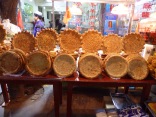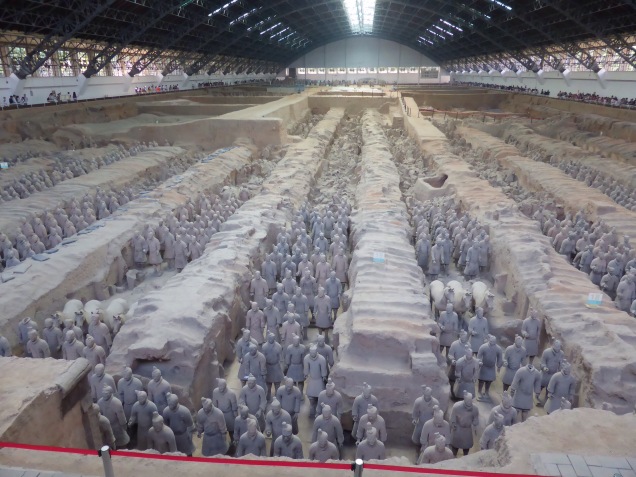Travelling south to Xi’an via bullet train we passed many very large cities and large areas of food production. With China having approximately 1.4 billion people to feed, farming of every sort is huge and crops of fruit and vegetables are grown on every spare peice of land in the countryside.
The cities are developing at a huge rate; with many people being moved off the land into city apartments as their small farms are being bought up by large corporations. Having said that, we saw hundreds of high rise developments that are unfinished. Given that China still has a restricted child policy it seems unimaginable that these developements will be filled for years to come.
Xi’an was the first capital of the united China (before Peking) and the largest city in the world at that time and the start of the Silk Road. Today it has a population of around 8.5 million plus another 1.1 million university students as the city is home to 50 universities, each specialising in it’s own field.
In Xi’an we visited the Wild Goose Pagoda where the Buddhism scriptures were translated into Chinese which happened after the Silk Road extended into India.
The preserved ancient city wall around the old city of Xi’an was built in 194BC to fortify the city from invading armies. It is still intact and a very popular to walk and cycle around.
One of the popular places to visit is the Moslem area which comes alive in the evening. Food and a variety of wares are very popular with the locals.
Just out of the city the amazing discovery of the Terracotta Warriors, regularly called the 8th Wonder of the World, is the most significant archeological find of the 20th century. The 8,000 warriors, archers, horses and chariots, of which only a small number have been unearthed, were made to guard the tomb of Emperor Qin in 210 BC. The Emperor believed that the warriors would protect him in his afterlife. Made of clay from the local area the warriors were colourfully painted but archeologist have discovered that once the warriors are exposed to air and light the colour disappears. Sonar and other means of detection reveals that the colour is still evident on the unearthed warriors so at this stage some of the work has been stopped until technology comes up with a way of preserving the colour.
Such a fascinating place….all to guard the afterlife.















































Reblogged this on Jim & Kerry.
Fabulous and just a wonderful experience you have made me more determined to see it all . I will call to find out who you travelled with
We will have to catch up and tell you all about China. You will love it.
I would love to see the Warriors…one day.
You must….it is fascinating.
I saw some of the statues in perth many years ago, but to see them on mass like that is amazing.
The site is huge….and to think they have only uncovered some of the statues at this stage is mindboggling.
Amazing seems inadequate to describe the sights. The sounds and smells of the open markets must be something you can only really sense by being there.
The Warriors were amazing…..as were the sights and smells.
Quite surreal looking
The faces of the Warriors were all different, as were the horses.